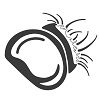It’s a quiet morning and the light rocking of the floating dock, small lapping of tiny waves against the shore, and clunking of boots on weathered planks can be heard. The field team arranges gear on a small skiff that will take us out to where our three stations on the bay are located. The waters are calm and we easily start our journey to sample the first of four (Willipa Bay, Case Inlet, Port Gamble Bay, and Fidalgo Bay) field stations.
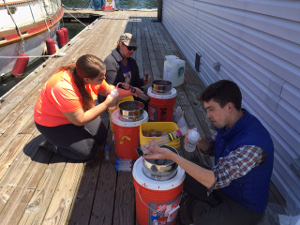
What brought us out here in the wee hours of the morning one might ask? In this posting, I invite you all to read up on some of the methods we used this summer in the ocean acidification project we’re collaborating on with Washington State Department of Natural Resources (DNR). Looking back, this all started with the DNR’s past work relating to changes in water chemistry due to different conditions over patches of eelgrass meadows, and spots where no eelgrass is present. As plants photosynthesize and respire, there is a measurable change in pH conditions over a day. Since it is now night, and given that plants always respire and only have the ability to photosynthesize during the day, the net CO2 is much greater during nighttime hours, which is leads to acidic conditions. This pattern is reversed during the day, with photosynthesis leading to more basic conditions. For more information on changes in pH conditions in Washington State click here.
As you can imagine I’m sure, the next question DNR asked was: “What types of organismal responses will we see over these different patches during times when the water chemistry is most changed?”. The organisms of interest were four species of bivalve larvae (two-shelled babies): the Pacific geoduck, the Pacific oyster, the Olympia oyster and the Manila clam. These species were chosen not only because of their economic importance, but also because of their vulnerability to ocean acidification, especially during their larval stage when mortality is at its highest. Aside from using methods to investigate different water parameters that larvae experienced during their planktonic stage (temperature, water flow, water chemistry), the team had to devise a way to collect and preserve larval samples. How did they set out to investigate how bivalve larvae may be distributed among bare and eelgrass patches? That’s where the Becker Lab comes into play (or maybe we should say “comes out to play!”).
Olly olly oxen free! Unfortunately hunting for bivalve larvae is a lot harder than a child’s game of hide and seek, although in some ways it’s much the same. For the Becker Lab we use multiple methods to seek out our microscopic hiders. Methods include larval pumping, where we pump and filter seawater to collect plankton samples. Using the same stations and site locations we systematically set out larval tube traps with a concentrated salt solution in them for two-week intervals. These traps passively collect plankton samples as they flow above the trap. Lets go over these methods in more detail, shall we?
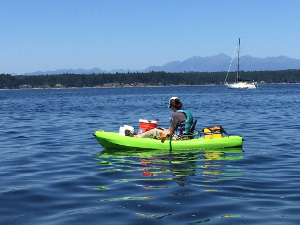
Larval pumping gives scientists a snapshot of where bivalve populations may be relative to both bare and eelgrass patches during specific times of day. For this method, team members kayaked to specific sites where both eelgrass and bare patches were to be sampled in both deep and shallow settings, at both dawn and midday, referencing back to peak times of photosynthesis and respiration. Here it was determined that kayaking was the best fit, not only because this prevented disturbing larval populations while pumping was in progress, but also because we were getting pump samples at three locations during the same periods of time- it was more cost effective than renting three boats with captains. While waiting for a pump sample to complete, the field technician sat in calm waters and was able to bask in their surroundings. The only thing to be heard was the soft “chreet chreet chreet,” of the field pump as it pumps out gallons of water into a large bucket with a filter set at the top collecting plankton as the water passes through. One of the few challenges the technician has is the limited room a kayak has to offer when maneuvering equipment around on the vessel. This is especially challenging when funneling the final sample into a 50ml vial, using 95% ethanol as a preservative, in a rocking kayak. My suggestion to a future technician is to get lots of practice- not in the sieving and collecting part- just in kayaking, or you may get a little wet…. I, sadly, know from experience. Bit of advice- don’t over correct yourself with the paddle to quickly… the kayak will tip over and you will be swimming instead of kayaking. Now, pumping samples has its challenges yes, but it is also very rewarding. Aside from scientific understanding, who else can say they spent the day kayaking during work hours- unless you are a kayak instructor of course.
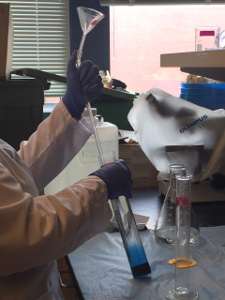
Although snapshot larval pumping data is fascinating to us larval bivalve trackers, knowing the abundance and distribution patterns of larvae over a longer period of time is equally important. This is where larval tube traps come into play. The information we get from tube traps give us data relative to the spatial distribution patterns of where larvae are throughout our sites. Are they more abundant in eelgrass meadows or bare patches, or is there no difference? The information can also be compared to changes in water conditions that larvae are faced with or even tell us roughly peak times of larval abundance over time in reference to different sets of traps we put out. To collect larvae using this method, mailing tubes are sealed on the bottom and filled with a concentrated salt solution using dimethylsulfoxide (DMSO, a common solvent used in caring for horses) as a temporary preservative for our samples. This solution sinks to the bottom of the tube and using a food coloring we were able to visually see that the solution stayed at the bottom of the tube until deployment. We wanted to keep the preservative at the bottom of the tube because as the larvae flow over and get sucked down into the tube, we wanted to make sure that the larvae stayed there. If, for instance, the tube dropped and the solution mixed with the less concentrated seawater, there would be no telling if the larvae would stay at the bottom of the tube, let alone get sucked down into the tube. Then we topped the whole thing off with regular seawater. The tubes were anchored at the bottom of the bays so that only a couple of inches of the tubes were exposed using PVC tubes among our stations so that there was a set of three per bare and eelgrass patch for each site; we put three out to give us extras just in case one broke while in the field or was other wise unable to be quantified. Here the traps stayed for two weeks until they were collected and swapped out with a new set of tubes. When they were collected, like the pump samples, they were filtered and preserved in 95% ethanol for later analysis. This time while filtering, we were on shore. So the challenge wasn’t in having to do it in a moving kayak, it was in how long the filtering took due to the amount of sediment that was trapped in the tube along with our sample. The Willipa Bay samples were always the most difficult, sometimes taking more than a day to filter all 18 samples because they were so heavily loaded with sediment.
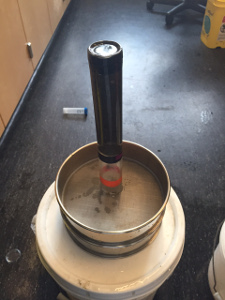
Another issue here was how hard it could be getting to the traps because of the extremely muddy conditions at some of the sites. More than once I had to pull a leg free of the quicksand like brown gunk only to have to pry loose my other leg, a vicious cycle where one had to eventually climb out on all fours and crawl to safety. But, when it’s all said and done, everyone had a blast. After all, there isn’t one person in the Becker Lab that doesn’t like to get a little muddy!
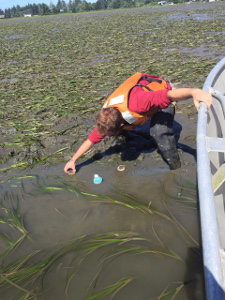
The field season for this project is now over I’m sad to say. There were a lot of great partners that worked on it and a lot of fun memories. Although we won’t be getting muddy anymore, the Becker lab is still knees deep in samples that need to be processed. Look forward to future blog posts that will detail how we process the samples using qPCR with our other collaborators in the Roberts Lab up at the School of Aquatic and Fishery Sciences at the University of Washington Seattle campus! Can’t wait to see the results!
